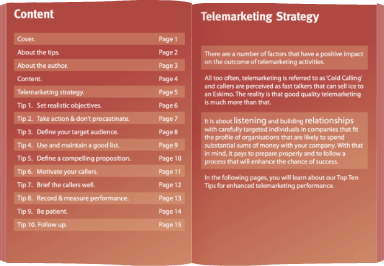Despite the advent of more online ways of selling, telemarketing remains important as a means to generate new and repeat business for many b2b marketers. This could be due to the fact that it is a direct peer to peer channel in a world where, thankfully in most high quality, high value business deals, people still buy people. Given that even in product-based businesses, service is very much part of the decision-making process, the human element is one of the factors in the ultimate decision. As a consequence of these and other aspects, b2b telemarketing persists alongside other lead generation routes to market.
It’s fair to say here that not all telemarketing is cold where prospecting is the order of the day. Many outbound calls are for customer care, product launches to existing customers and cross-sell and up sell communication. And, of course, there are research/customer satisfaction calls and other contact that isn’t straight prospect calling to a cold data pool.
So, whilst a lot of focus goes on telemarketing as a proactive means to generate new business, there are elements to it that can relate to contact with infrequent or lapsed customers and even current customers with whom you don’t have frequent communication.
Whatever the reason for the call, telemarketing is a process. There are disciplines and success factors that play a big role in success. And, it pays to learn how to run a successful telemarketing campaign. Check out our key factors below:
1. Segment and profile your data at the outset
Good telemarketing starts with good strategy. It shouldn’t just be about spraying calls around and hoping someone (anyone) will be interested. You need to align your approach, target audience, management and measurement in order for telemarketing outbound calling to be effective.
With por data you’ll definitely achieve weaker results. The more targeted the calling the better. There are so many variables so you have to decide what those are for your specific campaign. And, it will likely vary each time.
You could segment by last order value. It could be based on location or company size or sector or all of these. It could be based on the last contact date. Or, if you have a proposition for a specific job role, perhaps that may be your key criterion.
However you approach segmentation, it pays to focus the calling on a specific audience not least for consistency. But, make sure that you have good contact information in the first place. A poor marketing list with outdated contact details will certainly derail your telemarketing efforts. It will slow down the calling, reduce positive outcomes, take more time and cost more money. You will receive more gatekeeper blocks and hit more organisations with no name policies, all of which serves to reduce effectiveness. So, make sure that the data you provide to your callers is accurate and recent.
2. Identify the right message
It seems simple but it isn’t always executed in a way that ensures that the desired outcome is achieved. Why is it that many telemarketers still persist with tired old opening lines that are focused on themselves and prefaced with an insincere “how are you today?” As if they cared!
The key to how to make a telemarketing campaign successful in this respect is to focus on the recipient of the call, their woes, their issues and challenges. Try to work out what, typically, keeps them up at night. It isn’t about your products and services. They don’t care about them. They are only interested in their priorities and how what you offer helps them to achieve their goals. So, ensure that your opening gambit and core message resonates. Base your entry point on things that will matter to them.
3. Proactive Management is key
When we run campaigns for clients and training courses for telemarketers, we often find that one of the main things that detailed past campaigns was lack of proactive management. As mentioned earlier, it shouldn’t be about simple giving a telemarketer a list and telling them to make calls. For example, there are many different outcomes from a telemarketing call. To start with, you need to identify the desired outcome. Is it a face to face appointment for a field sales representative that’s required? If so, why would the prospect (or customer) want to see you?
Do you need to have a prequalification call? Is it an online demo or webinar or attendance at an event that’s needed. Is it a customer care/customer satisfaction requirement? There are lots of options and being crystal clear about the right one and/or options is important. Equally, what are the KPIs that will provide the desired ROI? What benchmarks do you have? And, how and when do you measure success? Over what timeframe? How do you monitor results and what should they realistically be?
Having an account manager that understands how to make a telemarketing campaign work is essential. Leaving telemarketers to do their own thing is a bad option. Failing to track performance and the inability to provide guidance and constructive feedback is guaranteed to produce failure. Even if you have only one caller, they need input especially where they hit inevitable roadblocks.
4. Measure and report
Whilst proactive management is crucial, it’s hard to be proactive if you don’t have the right systems and measurement in place. A poorly configured CRM system or, heaven forbid, no system, slows down calling and makes those crucial follow up calls much more difficult. Telemarketing is very much a process and your system needs to provide simple ways for the telemarketer to make initial calls and subsequent follow up calls. They need past notes, order history and other information at their fingertips and, ideally, on one screen in order to speed up calling. The right layout allows for momentum which is essential if you want good results.
And, whoever manages the calling process needs access to information to evaluate performance. They need this regularly. We’d recommend daily reporting and benchmarking. Monitoring the right KPIs will ensure the campaign doesn’t go off track. You should measure the amount of time calling, admin time, call numbers, decision-maker conversations, outcomes by type and ratios for all of these and more. By comparing results by telemarketer, by day, by sector and so on will enable you to tweak whee necessary to ensure you get better results. Without measurement, it’s hard to deliver the success.
5. Watch Your Call rates
We always say that you’ll never do any business with someone you don’t call. Of course, that doesn’t take into account inbound leads and online enquiries. We’re purely talking about outbound calls here. What’s for sure is that poor call rates, often driven by failure to action the elements of the campaign mentioned above, will cause a telemarketing campaign to fail. Voicemail, gatekeepers, out of office, no name policies and other factors mean that even if your database is 100% perfect, you will not get through to everyone.
If you get through to 25% of the contact list, that’s not a bad benchmark from a day of calling. With that in mind, if you only make 40 calls as opposed to 100, you’ll be at least 60% less likely to reach your goals. A bad call is a bad call and 100 bad calls isn’t as useful as 40 effective calls. But, that notwithstanding, 100+ dials is where you should be aiming so that you maximise the value of the 25 decision makers you do speak to.
6. Focus on Motivation
Let’s face it, telemarketing is a rough job. It can be repetitive when you’re not having many conversations. Push backs, blocks and rejection are part and parcel of the role. Therefore, keeping your telemarketers motivated is a crucial part of the success story. Some sectors are tougher than others. If you have an undifferentiated proposition to an audience that is locked into contracts, it may well be a thankless task. This is where motivation comes in. Management needs to consider how to change things around to provide greater impetus where telemarketers are having a hard time. Leaving them to their own devices rarely works. Regular meetings and reviews and/or conference calls keeps them on their game and provides necessary stimulus for continued success. Allowing them to provide their input and feedback can unearth new ways to improve performance.
7. Be Flexible
Flogging a dead horse is never a good idea. And, some b2b telemarketing exercises are difficult. Perhaps other marketing routes haven’t proven successful and telemarketing is another option. But, not every campaign is successful and an effective account manager needs to know when to say no, when to change things and when to stop. Having appropriate KPIs and measures in place allows that flexibility. And, those managing telemarketing campaigns need to know when a tweak is needed and when to be patient if results aren’t coming immediately. There are any number of elements that could potentially be causing the campaign to fail. It could be poor data. The telemarketer may not get the proposition or they may be struggling to overcome a particular objection based on lack of knowledge. It could be that this sector is just too hard to penetrate when the cost of sale is high and contracts are long.
Successful telemarketing campaigns result from flexibility alongside transparency with a big dose of persistence and pragmatism.
8. Pay Attention to Detail
Sometimes callers can get carried away. They can focus on one section of the calling database at the expense of moving on. They can move on too quickly without working across individual companies. The role of an account manager is very much to have an eye for details. Is the list becoming tired or have calls been out in too sparingly. Is one sector providing better results than another and should you change the caller if they’re not getting it? Those running outbound calling exercises need an eye for detail to ensure that they don’t trundle on and result in failure.
9. Take Care with Pipeline Management
Whilst headline results are the most important aspect of success, what sits behind that is the driver of that success. It usually takes time to build up the sales pipeline. It can require multiple calls and emails to qualify relevant opportunities. Some prospects just aren’t ready to buy but may be open to further dialogue in 3 or 6 months when they’re closer to contract end dates or new budget periods.
Recognising and managing this is key to developing a bank of leads that aren’t necessarily ready to convert immediately but that are in the market. Certainly, where higher values of sale are concerned, it’s rare that prospects will commit straight away. Sometimes, a telemarketer strikes lucky and calls at just the right time. However, it’s unwise to rely on this and pipeline management is usually crucial for long-term results. That means following up by sending a relevant email, call backs at the agreed time and using other channels such as LinkedIn to keep in touch. Policing this approach is fundamental to ensuring that your lead generation campaign goes to plan.
10. Training and briefing your callers
A good telemarketer is skilled in handling objections, blocks and swerving curve balls. Some of those skills may be innate but some results come from effective briefing and training. A good account manager will ensure that the callers have clear briefing about required outcomes and the reason why a prospect or customer should engage. And, it shouldn’t just be what your company offers. Once again, any briefing need to reflect client needs and challenges.
The telemarketer also needs clarity on typical industry acronyms and trigger points to use in the call. Selecting the right telemarketer and briefing them well is vital and, changing the caller is also important if things don’t go to plan. It’s better to change swiftly than to leave things running where there’s a risk of brand damage.
Excerpt
Telemarketing isn’t the easiest job in the world. Sometimes, it’s tough and, to achieve results, everyone in the team needs to pull together. One of the most important aspects of telemarketing success is account management. That means aligning all of the elements to make a campaign work. Check out our blog for 10 tips on how to run a successful telemarketing campaign.






